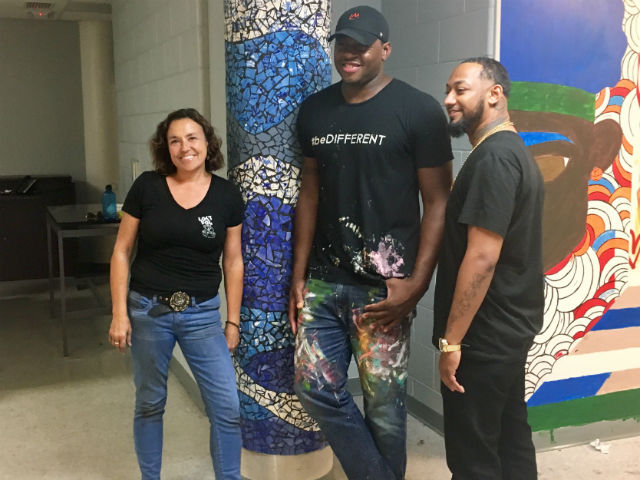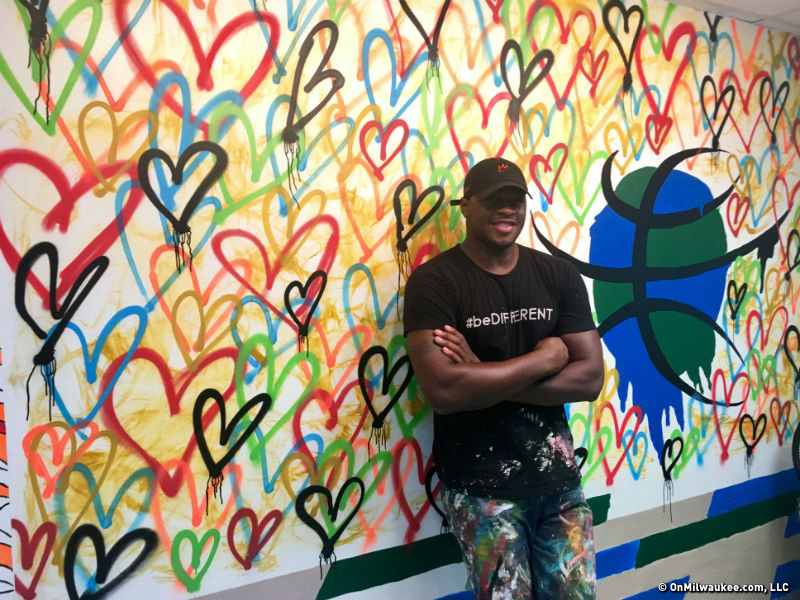Wearing a respirator mask around his backwards black hat, a T-shirt with the message #bedifferent printed on it and splattered jeans, retired basketball player-turned professional artist Desmond Mason set to work spray painting multi-colored hearts on a wall mural at the Running Rebels Community Organization’s new facility in the city’s historic Harambee neighborhood on Friday.
Mason, the former Bucks fan favorite who has recently become actively involved again in Milwaukee through the organization’s Legends alumni program, teamed with the Running Rebels and local artists to help create, paint and design two murals and two mosaic pieces now displayed at the organization’s new location, 225 W. Capitol Dr.
Since the end of his decade-long NBA career, Mason has continued to pursue his passion for the arts, finding success in a variety of media, but particularly as a highly skilled painter. As he did during his playing days, Mason uses his art to benefit many charities, including ones in the Milwaukee area, looking to create positive change through his philanthropic work.
On Wednesday, the Bucks Foundation announced a $1 million grant to 15 different local nonprofit organizations, with an emphasis on youth mentoring. One of the awardees was the Running Rebels, which will receive funds for critical mentoring, educational enrichment and athletics programs for at-risk youth, especially African-American teen boys living in Milwaukee’s central city.
Mason worked with two Milwaukee-based artists, Vedale Hill and Carrie O’Malley, on the project, an artist-in-residence opportunity made possible by the Bucks Foundation through a donation. Both of them were on hand Friday, along with Mason, to implement the Running Rebels’ pieces and interact with the youth there.

From left: O'Malley, Mason and Hill
Hill is the owner of Jazale’s Art Studio Inc., which promotes arts and education in the community by providing children with instruction and exposure to a diverse range of arts, along with homework help. O’Malley is an artist and educator who specializes in mosaic art, mosaic murals and painted murals, and she aims to bring beauty to public spaces and to empower kids and adults to be creative thinkers. She’s been commissioned to create and facilitate murals both locally and internationally throughout her career.
The Running Rebels moved into the building a few months ago, and, according to Bucks Foundation Executive Director Alicia Dupies and her Community team members, the walls were a vast expanse of lackluster white space. Pro Trade Job Development found painters to color up many of the walls, but the Bucks Foundation decided to reach out to Mason about customizing a couple areas in the organization’s rec room/common space.
Mason said agreeing to do it was "a no-brainer," and he, Hill and O’Malley settled on a mural concept emphasizing love and self-expression, with some basketball elements and the Bucks’ sleek blue, green and cream color scheme.
Dupies said one of the benefits of bringing in Mason, a guard/forward who last played for the Bucks in 2008 and whom many of the kids might not even know as a professional athlete, is that he can show them a life after basketball – that "there’s not just one path to success," she said. And because of the local collaboration, if some of the kids are inspired to follow an interest in art, even after Mason leaves, they can visit Hill’s local studio or continue to work with O’Malley.
We spoke with Mason on Friday at the Running Rebels’ facility about the project, his art and what he thinks of the Bucks – on the court and off the court, including his opinion of ownership and the new Downtown arena.
Desmond Mason is painting murals (and running out of room for his hearts) at the Running Rebels Community Organization for @BucksCommunity. pic.twitter.com/4ICHEBMzHG — Jimmy Carlton (@jimmycarlton88) July 21, 2017
OnMilwaukee: How did this partnership and the artistic idea come together?
Mason: I’ve been coming in and out of town with the Bucks – just doing community stuff, appearances, going to games, getting re-acclimated to the community in Milwaukee – and we’ve been talking about some options, doing things with the community from an art standpoint, utilizing the talent, artistically, that I have and engaging with the local community through some projects.
This was one of the ones that we had on tap, and a couple months ago we conceptually discussed it. Now seeing it all come to life and having the kids engage with it, man, it’s amazing. We’ve had fun the last couple of days; unfortunately, I have to leave today, but I’m looking forward to coming back and seeing the finished product, as the kids continue to work.
You live in Oklahoma City now, but you played with a few different teams during your career. Are you involved like this with the local communities in other cities where you played, or do you have a particular connection with Milwaukee?
I was engaged in every city I played in with the community: Seattle, Milwaukee, Oklahoma City and Sacramento when I finished my career. When I retired from basketball, I really wanted to live in Oklahoma City or Milwaukee, that was going to be my decision, but it was because I was really engaged in those communities and it kind of felt like home to me. To have the opportunity to come back and work with the Bucks, it was a no-brainer when it was discussed.
In Oklahoma City, I do a lot in the community artistically, that’s where my studio is, that’s where my gallery is, that’s where I’m based out of. But Milwaukee is a special place. I played here on two different stints (2003-05, 2007-08). I have a lot of friends here, obviously the organization has been very good to me and I had some great years here – my best playing years. So it was a no-brainer when I was asked to come back.
How does a project like this work conceptually and, to you, what does it represent?
Conceptually, this is phase one. Me and (Hill an O’Malley) got together, had the kids sketch and draw out some ideas that they wanted to incorporate into this piece. Carrie and I talked a couple months ago about doing the mosaics and what that would be like, then we walked through the space and talked about some mural work.
But having the kids sketch stuff, and then taking that and putting it onto the walls and having them paint it. And then all of us getting together, breaking tiles and making the mosaics, it’s ground-level artwork – stuff that these kids can take away and maybe utilize at home, a way to express themselves. Watching that process from start to finish has been really amazing.
Is this representative of your typical artwork?
Not necessarily. I’m an abstract expressionist, and this is a conceptual project, so a lot of it has to fit what they’re trying to accomplish here. My work is usually large scale – some of it’s much larger than this – murals on buildings, abstract expressionism on canvas, wood sculpture.
I just finished a city project in Oklahoma City; we did a nine-ton, 18,900-pound American flag that we had to crane in and install. It’s in downtown Oklahoma City and will be at a new contemporary art museum. I was fortunate to be one of the five artists picked to create a piece and I created this monster. But it turned out really cool. So that’s my style. I bounce all over the place a little bit with materials, but it’s still abstract conditions of expression.
I talked to (former Bucks center) Larry Sanders about his artistic interest and style, and I remember him saying he mostly avoided basketball stuff because that was his job and what he did all day long. Do you share that sentiment or do you do some basketball stuff too?
I mean, you can’t run from it. It is who I am. I played 10 years in the NBA at the highest level; I’ve been playing ball since I was 5. But I agree with that. To be successful in the art, world you have to be an artist. The art world doesn’t care about sports; they don’t care if you played sports, most of them know nothing about sports. You have to be creative and you have to find your own way and you have to work hard, so for me – I’m not a rookie in the art world, but I’m a four- or five-year player. In basketball relations, I’ve been painting for a long time, but in the world of art, guys are doing some amazing stuff across the country and all over the world.
But I’ve done some basketball-related things. I’ve painted on jerseys, but it’s all abstract. I don’t paint basketball players, I don’t draw basketballs; it’s not my thing. But I’ll use basketball materials or equipment to create some abstract, cool installations.

You don’t often get former Slam Dunk Contest champions that become professional artists. How did you get here?
It’s interesting you said that – my Slam Dunk trophy got painted recently. … I painted it. I’ve been painting since I was 11 years old. I started doing ceramics first, and it took me into more drawing and painting. During my four years at Oklahoma State, I was a studio art major, and from there in the NBA, I started having an exhibition annually for charities in the cities that I lived in. I did that every year, so I had well over 10 exhibitions, but 10 solo exhibits in my 10 years of playing.
It was a way to give back to the community and continue to grow the brand. But once I got out of basketball and retired, it was strictly what I did on a daily basis – apparel, design and so on, so it’s my life, it’s what I do.
Did you always know you wanted to be an artist after basketball?
Yeah, probably in my last five years is when I really started thinking about it. I established my company then, I started looking into more apparel design stuff, started doing live paintings, shoe design, collaborations with apparel companies. So it was kind of my step one in moving forward, preparing for retirement. So when I retired from basketball it was pretty seamless for me.
You said you painted your Slam Dunk trophy. Why? And what does it look like now?
It looks like a painted ball on a wood block. I was doing a photo shoot and I was painting sports equipment because it was a sports cover for a magazine, and so I just kind of said, I’m going to bring my trophy over. At the end of the day, I can take the plaque off it and have some trophy place make me another one and it’s still a Dunk Contest trophy, but I’m going to go ahead and paint over this one. A trophy’s a trophy, it doesn’t really matter.
Have you been following what the Bucks are doing under the new ownership, both on and off the court?
It’s been pretty amazing to watch. Obviously, driving past that monstrosity of an arena Downtown is going to be pretty amazing when it’s finished. But even just the updates to the Bradley Center that they’ve done since I played here, and the growth of the Downtown area and how the Bucks are engaging with the city and progressing Milwaukee as a whole.
Obviously the team is a young, talented team and the nucleus of guys they have, I’m hoping they stick around for a long time because they’re very talented. Everybody speaks of Giannis, but there is a lot of young talent here, and if they can keep these guys together they’re going to be something special.
The new ownership group has done a great job of bringing back veterans and engaging in the community and putting together a young team. Jason Kidd – I’ve been around him as a player and I still consider him a young coach in the grand scheme of things, so he’s learning as he goes, as well. If they keep this together they can be something special. They’re definitely on the right track.
You must like how they play – driving the lane, their up-and-down style?
Yeah, just rebound the ball and take off running, that’s the way you play basketball. No need to run plays, there’s no plays in the NBA. And if you’re open, let it fly.
Speaking of that "monstrosity" of an arena, do you have an artistic opinion on what the new arena looks like or is going to look like when it’s finished?
It’s pretty cool, man. The design is really cool, streamlined, cutting-edge; it has that contemporary, big-city feel to it. There’s a lot more to add – not just to the exterior, around the area, as well, and then the interior, it’s exciting. I’m looking forward to seeing what it’s going to look like, but right now, when you look at it from an artistic standpoint – and I know a little bit about architecture, not a ton – but it has that big-city feel to it, and I think that’s what they were trying to accomplish,
You could probably take care of painting some of the interior walls, right?
I can do that too (laughs). I could paint the rims.
Can you tell us about the murals that you painted here?
It was a group effort. It’s a lot of different minds and different directions, but it’s starting to come together as something that’s cohesive. My part of it was incorporating the hearts, because I think everybody in this group is doing this for the right purposes, everybody’s got their heart in the right place. And the kids love it. We love engaging with them and watching them enjoy this moment and this process. But that was my rendering. I had a lot of different thoughts in my head but I wanted to keep it simple. It’s a great space for the youth and a way to spread a little love here.
Born in Milwaukee but a product of Shorewood High School (go ‘Hounds!) and Northwestern University (go ‘Cats!), Jimmy never knew the schoolboy bliss of cheering for a winning football, basketball or baseball team. So he ditched being a fan in order to cover sports professionally - occasionally objectively, always passionately. He's lived in Chicago, New York and Dallas, but now resides again in his beloved Brew City and is an ardent attacker of the notorious Milwaukee Inferiority Complex.
After interning at print publications like Birds and Blooms (official motto: "America's #1 backyard birding and gardening magazine!"), Sports Illustrated (unofficial motto: "Subscribe and save up to 90% off the cover price!") and The Dallas Morning News (a newspaper!), Jimmy worked for web outlets like CBSSports.com, where he was a Packers beat reporter, and FOX Sports Wisconsin, where he managed digital content. He's a proponent and frequent user of em dashes, parenthetical asides, descriptive appositives and, really, anything that makes his sentences longer and more needlessly complex.
Jimmy appreciates references to late '90s Brewers and Bucks players and is the curator of the unofficial John Jaha Hall of Fame. He also enjoys running, biking and soccer, but isn't too annoying about them. He writes about sports - both mainstream and unconventional - and non-sports, including history, music, food, art and even golf (just kidding!), and welcomes reader suggestions for off-the-beaten-path story ideas.







